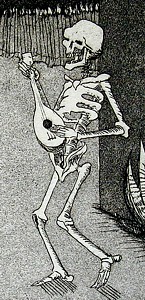|
 "The 'Dance of Death' motif originated no later than the early fifteenth century and seems to have appeared first in France before spreading to Germany, Italy, the Swiss cantons and even Spain. In its original form it was an elongated mural painting, either in a church or on the walls of a churchyard or burial ground. It depicted a series of figures both living and dead in procession. The living figures were generally presented in order of their social precedence on earth and there was usually an alternating series of living forms and cadavers or skeletons." "The 'Dance of Death' motif originated no later than the early fifteenth century and seems to have appeared first in France before spreading to Germany, Italy, the Swiss cantons and even Spain. In its original form it was an elongated mural painting, either in a church or on the walls of a churchyard or burial ground. It depicted a series of figures both living and dead in procession. The living figures were generally presented in order of their social precedence on earth and there was usually an alternating series of living forms and cadavers or skeletons."
 --Gundersheimer. The Dance of Death --Gundersheimer. The Dance of Death
 by Hans Holbein the Younger (Dover 1971). by Hans Holbein the Younger (Dover 1971).
During the sixteenth century two artists, Hans Holbein the Younger and Pieter Bruegel the Elder, continued the pictorial tradition of the "Dance of Death" motif in their own modes of depicting scenes of human mortality. Both artists used skeletons to represent "Death." Hans Holbein produced a series of 41 woodcuts entitled the "Dance of Death." Holbein's variation on the theme, however, was the pictorial statement of the omnipresence of "Death" and the indiscriminating and capricious nature of Death in whose eyes all men are equal. To Pieter Bruegel death was the result of sin rather than human frailty. In his painting "The Triumph of Death" Bruegel depicted Death as armies of skeletons whose victims had earned their "wages of sin."
James Ensor, a turn of the century Belgian artist, depicted skeletons in his work in a variety of roles; as self-portraits, playing billiards in carnival festivities and, of course, as the "herald of death."
"The fear is born when the elements and instincts are unleashed, when a force rages unchecked, when the normal balance is overthrown, when day light becomes dark night. It is born of the moments in which thoughts follow secret paths to communicate with forces that turn away from the divine will and the established order."
The "Calaveras" series was inspired in part by fear, but unlike Holbein and Bruegel it is not a fear of death, a fall from grace or the unknown. It is a fear of man's inhumanity to his fellow man and its consequences here on earth, among the living, where as a result rage and chaos continues its eternal cycle.
The world political arena is a rich source of material from which to draw such "fearful" inspiration (though by no means the only source), and so a few of the "Calaveras" may be viewed as wry political statements. I hope viewers will also see the satire and black humor underlying the violence, chaos, inhumanity, and grim games perpetrated by the Calaveras.
| |